 W
WKitchenware are the tools, utensils, appliances, dishes, and cookware used in food preparation, or the serving of food. Kitchenware can also be used to hold or store food before or after preparation.
 W
WA bowl is a round dish or container typically used to prepare and serve food. The interior of a bowl is characteristically shaped like a spherical cap, with the edges and the bottom forming a seamless curve. This makes bowls especially suited for holding liquids and loose food, as the contents of the bowl are naturally concentrated in its center by the force of gravity. The exterior of a bowl is most often round but can be of any shape, including rectangular.
 W
WA bread warmer can describe a number of different devices used to keep bread from cooling too fast. Examples include baskets with cloths, ceramic disks, or cabinets placed over a heat source such as steam radiators.
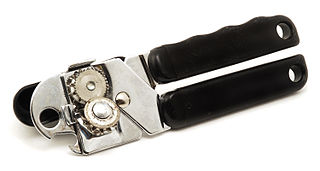 W
WA can opener or tin opener is a mechanical device used to open tin cans. Although preservation of food using tin cans had been practiced since at least 1772 in the Netherlands, the first can openers were not patented until 1855 in England and 1858 in the United States. These early openers were basically variations of a knife, though the 1855 design continues to be produced. The first can opener, consisting of the now familiar sharp rotating cutting wheel that runs round the can's rim to cut open the lid, was invented in 1870, but was considered very difficult to operate for the ordinary consumer. A successful design came out in 1925 when a second, serrated wheel was added to hold the cutting wheel on the rim of the can. This easy-to-use design has become one of the most popular can opener models.
 W
WA cherry pitter is a device for removing the pit from a cherry, leaving the cherry relatively intact. Many styles of cherry pitters exist, including small tools held in the hand, domestic crank-operated machines with a hopper, and industrial machines.
 W
WA combination plate can refer to several things, including:A combination meal A type of tableware A type of dental dentures Crystals and/or minerals that have formed in a combination, A printing plate that has both line drawings and halftones A combination wall plate molded with a variety of ports for various electrical items, such as switches and plugs.
 W
WDaunglan is a circular pedestal tray used to serve meals in Myanmar (Burma), especially in Upper Myanmar. Commonly made of lacquered bamboo, teak or beechwood, the daunglan is served with small bowls consisting of various dishes and soups. It is comparable to the khan tok used in Northern Thailand and Laos.
 W
WA decanter is a vessel that is used to hold the decantation of a liquid which may contain sediment. Decanters, which have a varied shape and design, have been traditionally made from glass or crystal. Their volume is usually equivalent to one standard bottle of wine.
 W
WA dipper well is a perpetual-flow sink often used in coffeehouses and ice cream shops to rinse utensils. Ice cream scoops and other food-preparation utensils can be placed under the continuous stream in order to remove allergens and protect against bacterial growth. Most dipper wells have a single spigot and can be adjusted for both hot and cold water use. As largely a commercial appliance, dipper well valves are typically kept at full flow during all serving hours. Dipper wells have also been used as key components in pharmacological experimentation.
 W
WAn egg timer or kitchen timer is a device whose primary function is to assist in timing during cooking; the name comes from the first timers initially being used for the timing of cooking eggs. Early designs simply counted down for a specific period of time. Some modern designs can time more accurately by depending on water temperature rather than an absolute time.
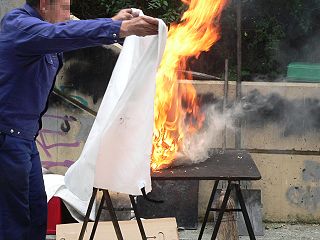 W
WA fire blanket is a safety device designed to extinguish incipient (starting) fires. It consists of a sheet of a fire retardant material which is placed over a fire in order to smother it.
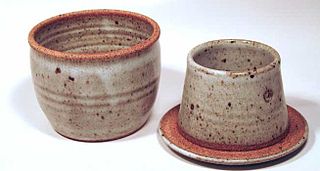 W
WA French butter dish is a container used to maintain the freshness and spreadable consistency of butter without refrigeration. This late 19th century French-designed pottery crock has two parts: a base that holds water, and a cup to hold the packed butter which also serves as a lid. The cup containing butter is placed into the base, where water creates an airtight seal that keeps the air away from the butter so that refrigeration is not needed, and the butter can be used in its soft form. This method will keep butter for around a month provided it is kept at temperatures below 80 °F (27 °C) and the water is changed regularly.
 W
WA honing steel, sometimes referred to as sharpening steel, whet steel, sharpening stick, sharpening rod, butcher's steel, and chef's steel, is a rod of steel, ceramic or diamond-coated steel used to re-align blade edges. They are flat, oval, or round in cross-section and up to 1 foot (30 cm) long. The steel and ceramic honing steels may have longitudinal ridges, whereas the diamond-coated steels are smooth but embedded with abrasive diamond particles.
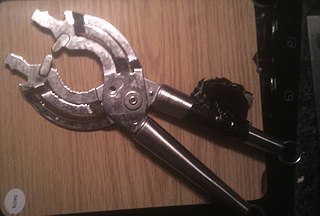 W
WA traditional jar opener will have two handles, leading up to two concentric grooved rings which can be used to fit different jars. It also sometimes has a device to open a bottle on it.
 W
WA juicer, also known as a juice extractor, is a tool used to extract juice from fruits, herbs, leafy greens and other types of vegetables in a process called juicing. It crushes, grinds, and/or squeezes the juice out of the pulp.
 W
WA kitchen utensil is a small hand held tool used for food preparation. Common kitchen tasks include cutting food items to size, heating food on an open fire or on a stove, baking, grinding, mixing, blending, and measuring; different utensils are made for each task. A general purpose utensil such as a chef's knife may be used for a variety of foods; other kitchen utensils are highly specialized and may be used only in connection with preparation of a particular type of food, such as an egg separator or an apple corer. Some specialized utensils are used when an operation is to be repeated many times, or when the cook has limited dexterity or mobility. The number of utensils in a household kitchen varies with time and the style of cooking.
 W
WA knife rest is a piece of kitchenware for resting a used knife without touching the table to prevent cooking fluids from getting onto countertops.
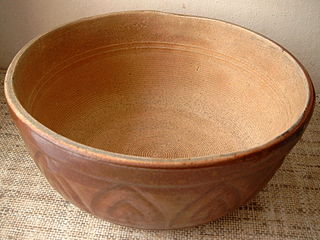 W
WA makitra is a big clay bowl with a rough surface. With the help of a special "ball", a makitra can be used for creaming cake batter, eggs with sugar, buttercream, quark for cheese cake, and poppy seeds for kutia. It is perhaps most used in Eastern European kitchens, for example in Poland and Ukraine.
 W
WMelamine resin or melamine formaldehyde is a resin with melamine rings terminated with multiple hydroxyl groups derived from formaldehyde. This thermosetting plastic material is made from melamine and formaldehyde. In its butylated form, it is dissolved in n-butanol and xylene. It is then used to cross-link with alkyd, epoxy, acrylic, and polyester resins, used in surface coatings. There are many types, varying from very slow to very fast curing.
 W
WA mixer, depending on the type also called a hand mixer or stand mixer, is a kitchen device that uses a gear-driven mechanism to rotate a set of "beaters" in a bowl containing the food or liquids to be prepared by mixing them.
 W
WA mortarium was one of a class of Ancient Roman pottery kitchen vessels. They are "hemispherical or conical bowls, commonly with heavy flanges", and with coarse sand or grit embedded into the internal surface. They were used for pounding or mixing foods and are an important indicator of the spread of Romanized food preparation methods. Stamps on some early Roman mortaria record the name of the potter, from which it is possible to trace their movement between workshops. Some vessels produced in Italy and Gaul are transported long distances but local factories dominate at most periods.
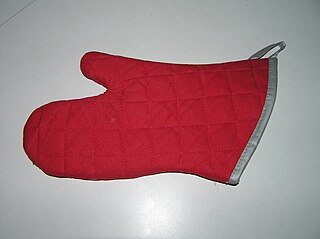 W
WAn oven glove, or oven mitt, is an insulated glove or mitten usually worn in the kitchen to easily protect the wearer's hand from hot objects such as ovens, stoves, cookware, etc. They are similar to pot-holders.
 W
WAn oyster glove is a special glove worn to protect the hand holding an oyster when opening it with an oyster knife. The oyster glove is worn only on the hand holding the oyster. These gloves traditionally are made with a heavy leather palm but are now often made of chain mail.
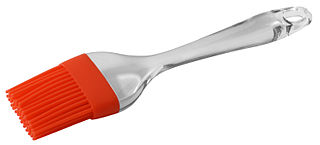 W
WA pastry brush, also known as a basting brush, is a cooking utensil used to spread butter, oil or glaze on food. Traditional pastry brushes are made with natural bristles or a plastic or nylon fiber similar to a paint brush, while modern kitchen brushes may have silicone bristles. In baking breads and pastries, a pastry brush is used to spread a glaze or egg wash on the crust or surface of the food. In roasting meats, a pastry brush may be used to sop up juices or drippings from under pan and spread them on the surface of the meat to crisp the skin.
 W
WA pie bird, pie vent, pie whistle, pie funnel, or pie chimney is a hollow ceramic device, originating in Europe, shaped like a funnel, chimney, or upstretched bird with open beak used for supporting or venting a pie.
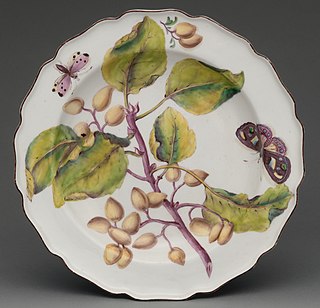 W
WA plate is a broad, concave, but mainly flat vessel on which food can be served. A plate can also be used for ceremonial or decorative purposes. Most plates are circular, but they may be any shape, or made of any water-resistant material. Generally plates are raised round the edges, either by a curving up, or a wider lip or raised portion. Vessels with no lip, especially if they have a more rounded profile, are likely to be considered as bowls or dishes, as are very large vessels with a plate shape. Plates are dishware, and tableware. Plates in wood, pottery and metal go back into antiquity in many cultures.
 W
WA pot-holder is a piece of textile or silicone used to cover the hand when holding hot kitchen cooking equipment, like pots and pans. They are frequently made of polyester and/or cotton. Crocheted pot-holders can be made out of cotton yarn as a craft project/folk art.
 W
WA pudding cloth is a culinary utensil similar to a cheesecloth or muslin. It is a reusable alternative to cooking in skins made of animal intestines that became popular in England in the seventeenth century for boiling a wide range of puddings.
 W
WA roasting pan is a piece of cookware used for roasting meat in an oven, either with or without vegetables or other ingredients. A roasting pan may be used with a rack that sits inside the pan and lets the meat sit above the fat and juice drippings.
 W
WA salt pig is a container used to hold salt, to make it easily accessible to pinch or spoon measure into dishes. They are available in many materials, but are generally ceramic, porcelain, earthenware or clay. The earthenware construction of a salt pig can help keep the salt from clumping in humid kitchens. According to the blog Mundane Essays, a blog in which writer Muness Alrubaiehis researched the origin of the term "salt pig," the use of "pig" is found in Scots and northern English dialect meaning an earthenware vessel.
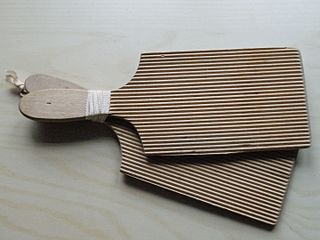 W
WScotch hands are wooden spatulas used when making butter. They are used to press freshly churned butter to remove the watery buttermilk during the butter finishing process, as well as to distribute salt through the butter. Removing the buttermilk and adding salt helps to prevent rancidity in finished butter. One side of the paddle will be ribbed or grooved to allow the buttermilk to drain away from the butter during pressing. The ungrooved side may be used for shaping the butter into final form. The highest quality Scotch hands are made out of sycamore wood, but they can also be made out of metal.
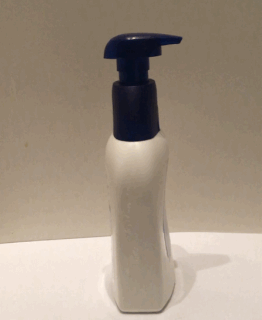 W
WA soap dispenser is a device that, when manipulated or triggered appropriately, dispenses soap. It can be manually operated by means of a handle, or can be automatic. Soap dispensers are often found in public toilets.
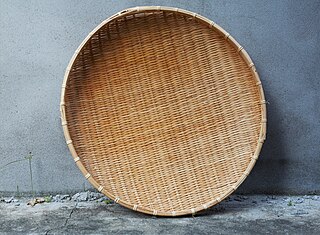 W
WSokuri is a round, rimmed woven basket made of finely-split bamboo. It is used for straining washed grains, drying vegetables, or draining fried food in Korea.
 W
WSpiral vegetable slicers are kitchen appliances used for cutting vegetables, such as zucchinis, potatoes, cucumbers, carrots, apples, parsnips, and beetroots, into linguine-like strands which can be used as an alternative to pasta.
 W
WA spoon rest is a piece of kitchenware that serves as a place to lay spoons and other cooking utensils, to prevent cooking fluids from getting onto countertops, as well as keeping the spoon from touching any contaminants that might be on the counter.
 W
WStainless steel soap is a piece of stainless steel, in the form of a soap bar or other hand-held shape. Its purported purpose is to neutralize or reduce strong odors such as those from handling garlic, onion, durian, guava, salami, or fish.
 W
WA steam juicer is a household kitchen utensil for separating juice from berries, fruits, and some types of vegetables in a process called steam juice extraction that is primarily used for preserving harvests faster than they can be consumed when fresh.
 W
WStock pot is a generic name for one of the most common types of cooking pot used worldwide. A stock pot is traditionally used to make stock or broth, which can be the basis for cooking more complex recipes. It is a wide pot with a flat bottom, straight sides, a wide opening to the full diameter of the pot, two handles on the sides, and a lid with a handle on top.
 W
WA round shaped container which helps keep tortillas warm during a meal. Warm tortillas are placed in the warmer, which is often lined with a cloth or paper napkin. Tortilla warmers made of terra cotta, plastic and styrofoam are available and commonly used in Mexican and Mexican-influenced cultures.
 W
WA vacuum filler is a machine used for filling pasty products. The pasty products are moved with the aid of a vane cell feed system under a vacuum.
 W
WA wet bar is a small bar used for mixing and serving alcoholic beverages that includes a sink with running water. This differs from a normal bar, usually called a "dry bar" that does not include a sink. A wet bar can increase the rate at which drinks are served because of the sink, which allows for glasses to be cleaned immediately. The sink may also be used for cleaning glassware as well as spills that may happen.